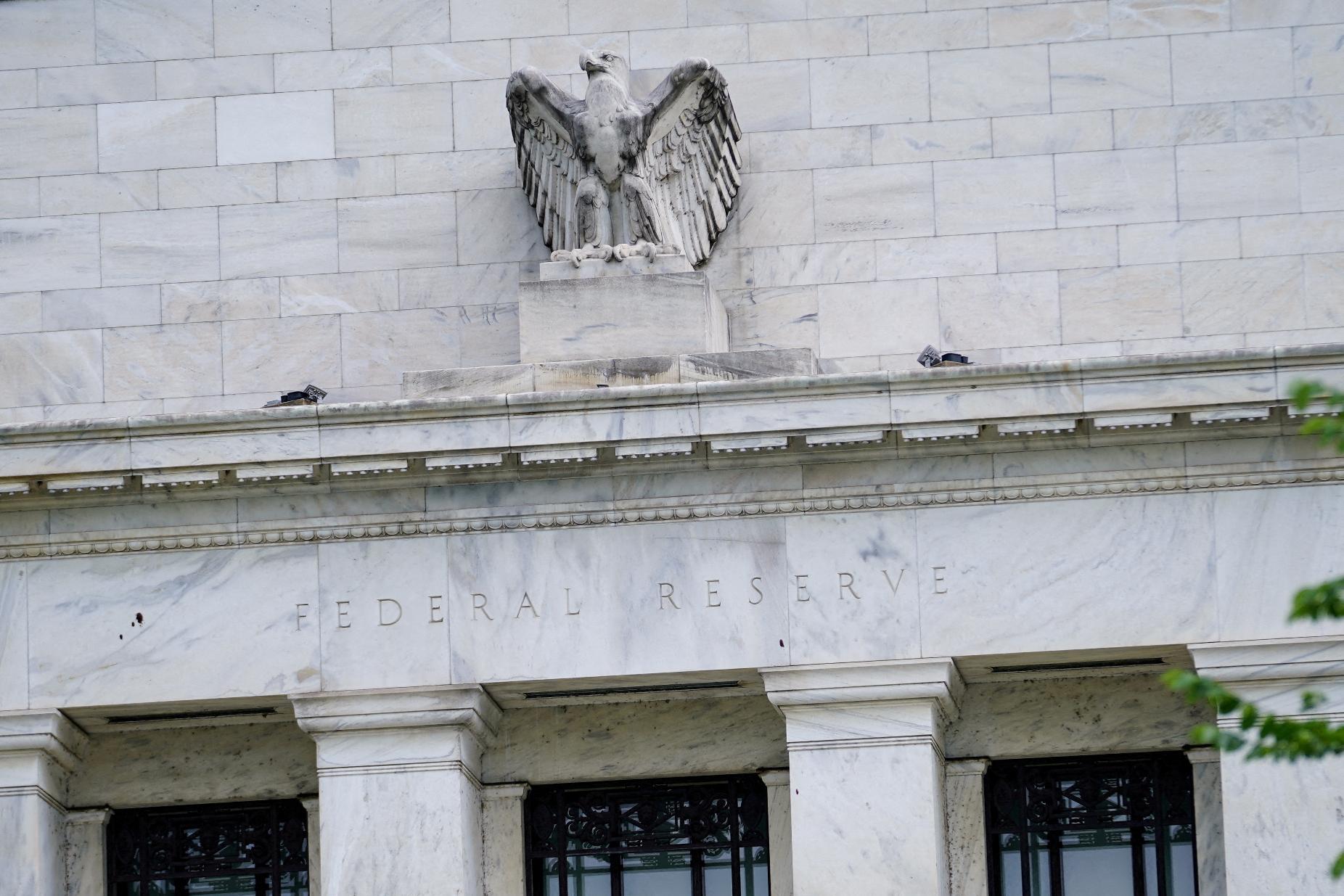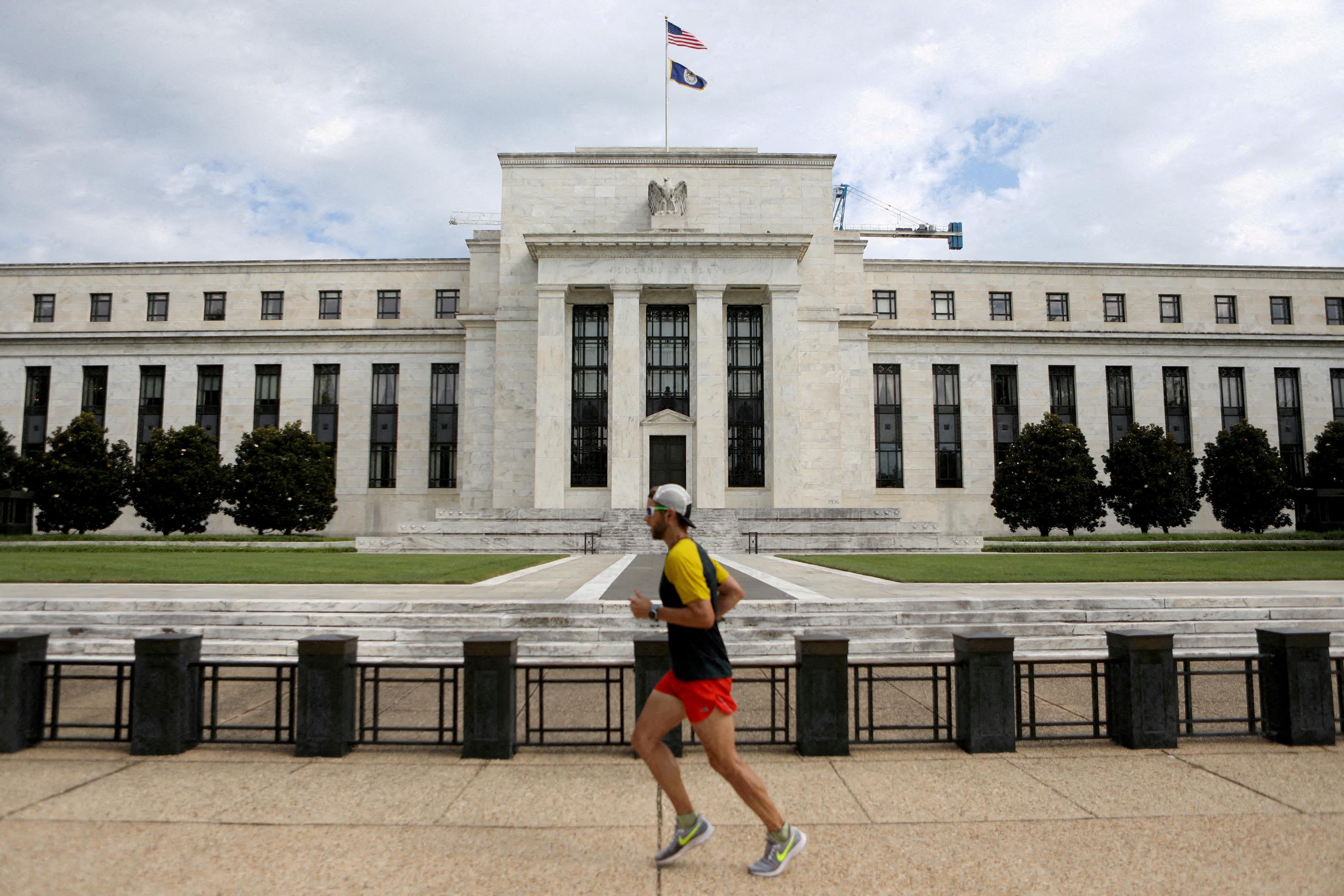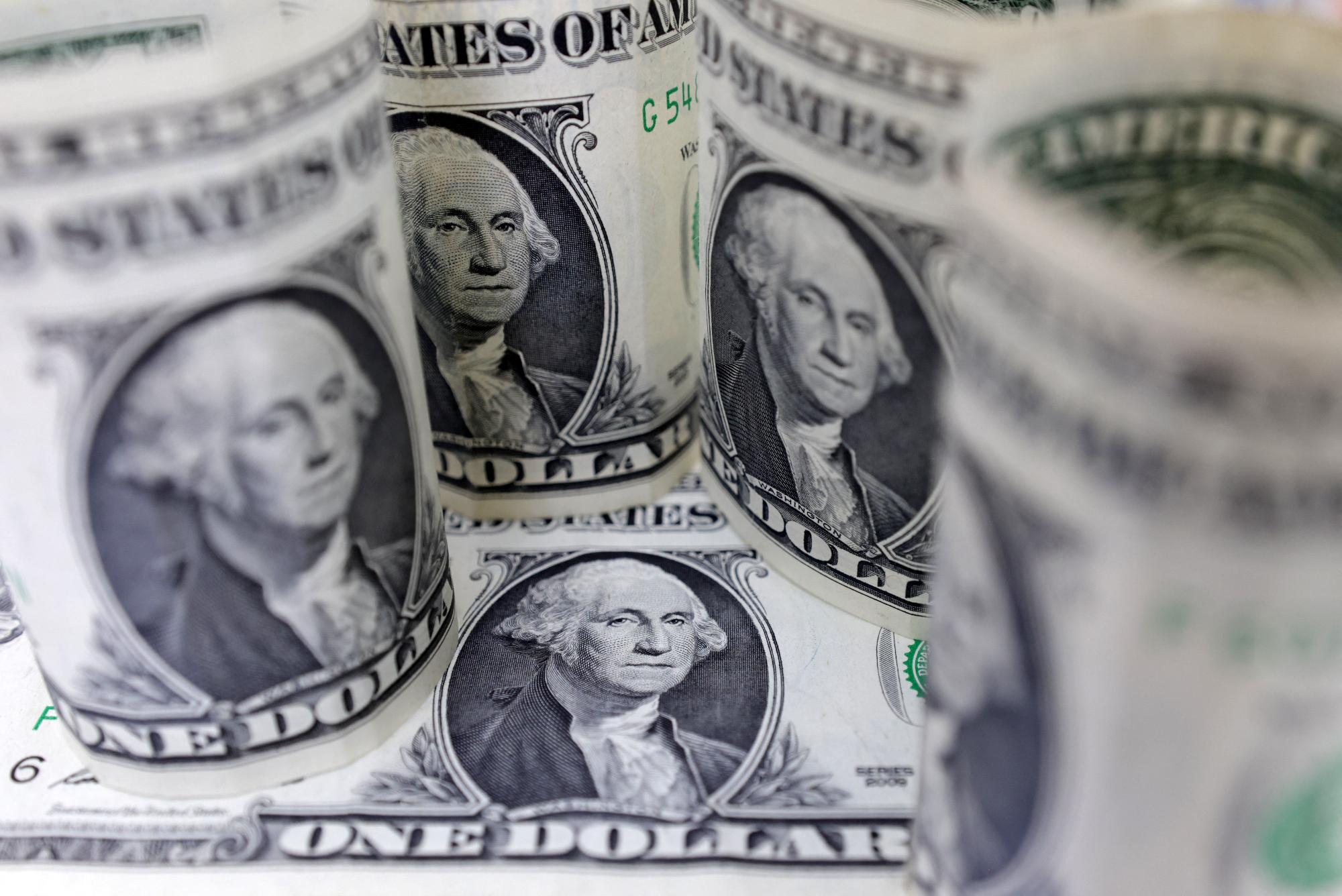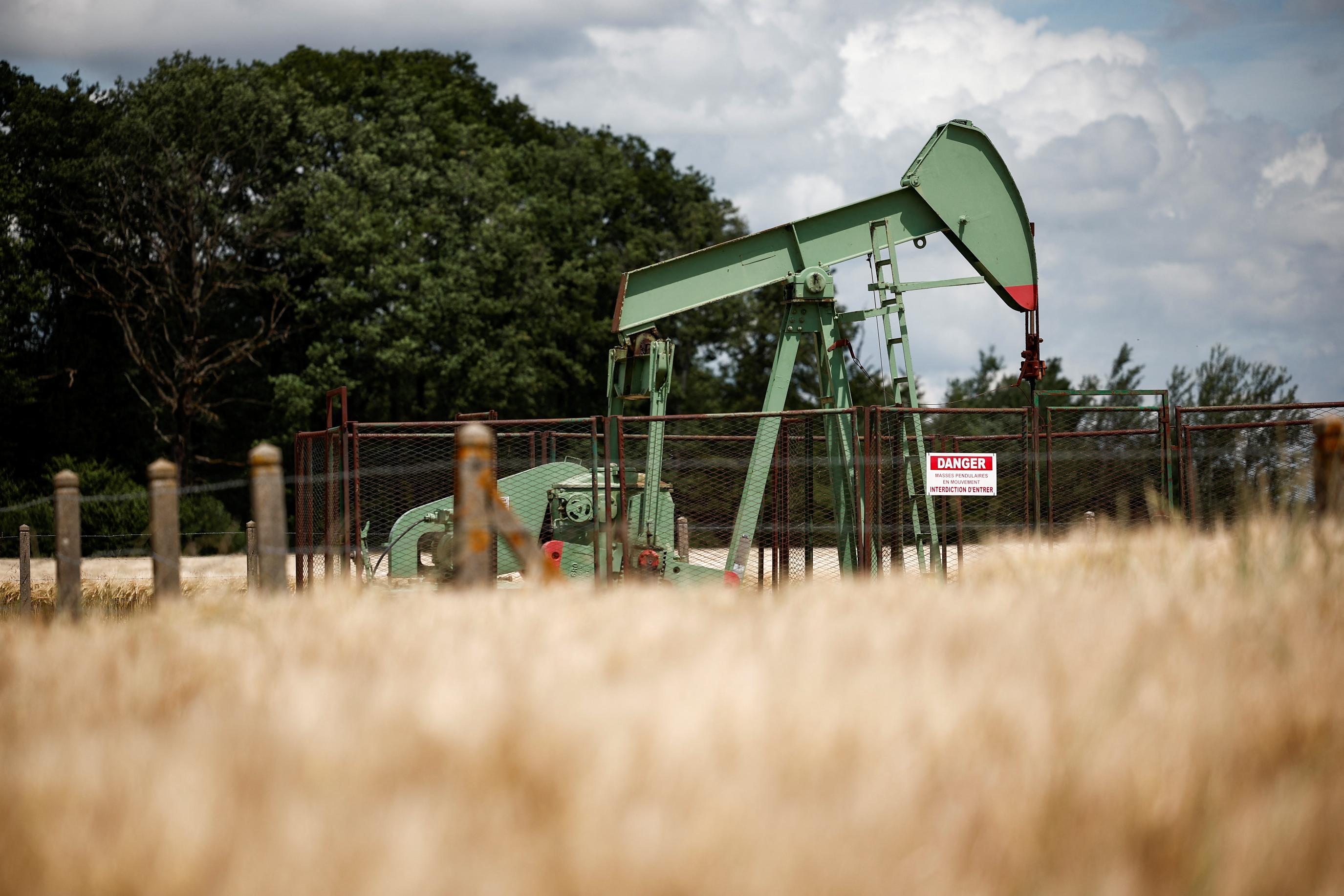
2024-08-22 04:33
A look at the day ahead in European and global markets from Tom Westbrook With the vast majority of Fed policymakers ready to go on interest rate cuts, a global easing cycle beckons. Lower U.S. rates leave smaller markets room to move. Already on Thursday the Bank of Korea had opened the door to a cut in October. Bank Indonesia has lined up cuts in the fourth quarter. Traders have been steadily selling the dollar, reckoning U.S. short-term rates - currently at 5.25-5.5% - have the furthest to fall. Markets have priced 161 basis points of easing in Europe by the end of next year and 135 bps in Britain, against 222 bps in the U.S. The dollar has hit one-year lows on sterling and the euro , which have each broken major resistance, as markets mull whether a cyclical downturn in the dollar is ahead. Purchasing managers' index figures in the U.S. and Europe due later on Thursday may gauge the relative momentum in each economy, though sluggish growth in the continent has been no barrier to the euro's powerful rally in recent weeks. A cheaper dollar tends to be positive for global growth, too, by encouraging emerging markets' investment and giving breathing space for other economies to hold interest rates lower, and a positive for commodities. Metal prices have been recovering from multi-month lows, helped by reports of more supportive measures for China's property market. Oil, meanwhile, has its own problems and traders are worried about demand as data points to a weakening economy. At $76.11 per barrel, Brent crude futures are near the year's low. Japanese factory activity shrank in August, data showed, though only just, while the service sector expanded. Key developments that could influence markets on Thursday: Economics: PMIs in Europe, Britain and U.S., U.S. jobless claims Earnings: Swiss Re Sign up here. https://www.reuters.com/markets/europe/global-markets-view-europe-2024-08-22/

2024-08-22 03:00
MUMBAI, Aug 22 (Reuters) - The Indian rupee is likely to open little changed on Thursday after the mostly dovish U.S. Federal Reserve minutes failed to lift Asian peers. The 1-month non-deliverable forward indicated that the rupee will open barely changed from 83.9225 in the previous session. The recent relief for the rupee proved short lived with the local currency now back to within spitting distance of the lifetime low of 83.9725. The rupee, having managed to climb to 83.7550 on Tuesday, has come under renewed pressure amid hedging by importers and lacklustre portfolio flows. The local currency on Wednesday declined 0.16%, its worst day in nearly two months. "Yesterday's move would not have been expected by most. It's just more evidence of the extent of the underlying dollar demand," a currency trader at a bank said. The near-term bias on the rupee is on the downside "or at least that it will hold near to 84", he said. The Reserve Bank of India has been intervening regularly across various markets to prevent the rupee from dipping past 84. FED RATE CUT BETS FIRM UP The Fed appears well on track to cut interest rates at the September meeting after a "vast majority" of officials indicated that in the minutes of its July 30-31 meeting. The minutes, in fact showed, that some policymakers would have been willing to reduce borrowing costs at the July meeting. A September rate cut had already been fully priced in before the minutes. The minutes "echo a dovish tone", ANZ Bank said in a note. Investors see the Fed cutting rates by a total of 100 basis points over the remaining three meetings this year. The downward revisions to U.S. payrolls further emboldened rate cut bets. Still, Asian currencies were weaker on the day, taking a pause following the recent rally. KEY INDICATORS: ** One-month non-deliverable rupee forward at 84; onshore one-month forward premium at 8 paise ** Dollar index up at 101.24 ** Brent crude futures down 0.2% at $75.9 per barrel ** Ten-year U.S. note yield at 3.81% ** As per NSDL data, foreign investors bought a net $481.6 mln worth of Indian shares on Aug. 21 ** NSDL data shows foreign investors bought a net $107.7 mln worth of Indian bonds on Aug. 21 Sign up here. https://www.reuters.com/markets/currencies/rupee-ignore-dovish-fed-minutes-bias-downside-2024-08-22/

2024-08-22 00:57
WASHINGTON, Aug 21 (Reuters) - The Federal Reserve appears to be very much on track for an interest rate cut in September after a "vast majority" of officials said such an action was likely, according to the minutes of the U.S. central bank's July 30-31 meeting. The minutes, which were released on Wednesday, even showed some policymakers would have been willing to reduce borrowing costs at last month's gathering. The policy-setting Federal Open Market Committee left its benchmark interest rate unchanged in the 5.25%-5.50% range on July 31, but opened the door to a cut at the Sept. 17-18 meeting. Financial markets have been expecting the September meeting to kick off the Fed's policy easing, with as much as a full percentage point worth of rate cuts expected by the end of this year. At the July meeting, most policymakers thought that "if the data continued to come in about as expected, it would likely be appropriate to ease policy at the next meeting," the minutes said. They also noted "many" Fed officials viewed the stance of rates to be restrictive and "a few participants" contended that amid an ongoing cooling in inflationary pressures, no change in rates would mean that monetary policy would increase the drag on economic activity. While all Fed officials were on board with keeping rates steady in July, the minutes revealed that "several" policymakers said progress in lowering inflation amid a rise in joblessness "had provided a plausible case" for a quarter-percentage-point cut in July, "or that they could have supported such a decision" had it been on the table. The minutes also showed that a dwindling camp of policymakers feared a premature easing in monetary policy could restart inflation. Jamie Cox, managing partner at Harris Financial Group, said "the Fed minutes removed all doubt about a September rate cut." He added that "the Fed's communication strategy is to make its meetings less of a market-moving event, and they are following the script to the letter." With the Fed letting the data determine what happens with rates, central bank watchers are already contemplating the future scope of cuts and whether aggressive action is needed at the onset of the easing cycle. "It may not be too heavy a lift for (Fed) Chair (Jerome) Powell to move the Committee now to a baseline of three 25-basis-point cuts in a row" through the end of the year, analysts at Evercore ISI said. They added that there's a "reasonably low bar" for half-percentage-point cuts, but that would likely require a "more pronounced weakening" in the job market relative to the softness seen in hiring data in July. BALANCE OF RISKS The case for cutting rates rests on the ebbing of price pressures back to the central bank's 2% target and increased anxiety about the state of the job market in the wake of recent data showing a rise in the unemployment rate. The speed of the jump in the jobless rate, which bottomed at 3.4% early last year and has since climbed to 4.3% as of last month, has added urgency to the debate over rate cuts and has prompted some analysts to say that a half-percentage-point reduction in borrowing costs should be considered next month. The minutes noted that officials see the job market as having largely returned to where it was before the COVID-19 pandemic started, and described the job market as "strong but not overheated." Markets showed little reaction to the release of the minutes, with stocks rising modestly to end the day higher and bond yields falling. Fed funds futures showed the probability of a quarter-percentage-point cut at the September meeting falling slightly from Tuesday and the odds of a half-percentage-point reduction edging higher. Powell largely tipped off the likely outlook after the July policy meeting when he said "if we do get the data that we ... hope we get, then a reduction in our policy rate could be on the table at the September meeting." The Fed's concerns about the job market may be underpinned by the Labor Department's estimate on Wednesday that 818,000 fewer payroll jobs existed in March than previously reported. The change was part of the annual benchmark revision process. Those revisions may not have caught Fed officials off guard, with the minutes noting "reported payroll gains might be overstated," which means the economy might not need to add as many new positions each month to keep the jobless rate steady. The minutes also noted that a "majority" of Fed officials saw risks to the job market as having increased while risks to the inflation mandate had been reduced. The current level of joblessness is already higher than the 4% level Fed officials penciled in for this year in their updated economic projections in June, and the 4.2% policymakers projected for the end of next year. Markets are likely to get an update of Powell's views on Friday when he speaks at the Kansas City Fed's annual research conference in Jackson Hole, Wyoming. A number of other Fed officials are also likely to weigh in on the outlook while attending the conference. Another major point for the monetary policy outlook comes in early September with the U.S. Labor Department's release of the employment report for August. Sign up here. https://www.reuters.com/markets/us/fed-minutes-show-depth-debate-over-july-rate-cut-2024-08-21/

2024-08-22 00:45
NEW YORK, Aug 22 (Reuters) - The dollar rebounded from a 13-month low against the euro on Thursday before Federal Reserve Chair Jerome Powell is due to speak on Friday and as the greenback’s recent weakness was seen as being overdone. The U.S. currency has fallen on concerns about a weakening economy and on expectations the Federal Reserve is close to cutting interest rates. But the extent of the weakness, and whether it will lead the U.S. central bank to cut rates by 25 or 50 basis points at its September meeting, remains in question. The odds of a cut of 50 basis points or more rose after July’s employment report showed fewer than expected jobs gains and an unanticipated increase in the unemployment rate, though this pricing has faded as other data points to better growth. "The dollar has been under a lot of pressure recently but I think it's getting to a place where it's quite a bit oversold," said Brad Bechtel, global head of FX at Jefferies in New York. “We've backed away a little bit from that sort of emergency place we got to after the payroll print, but the dollar seems to be pricing as if we're still in that emergency state," Bechtel said. A mass unwind of carry trades, in which traders borrowed yen to finance U.S. asset purchases, added to market moves after the payrolls report and made the rate cut pricing more extreme. Traders are now pricing in a 25% probability of a 50 basis point cut next month, down from 38% on Wednesday, and a 75% chance of a 25 basis point reduction, according to the CME Group's FedWatch Tool. Traders will focus on Powell’s comments on Friday at the Kansas City Fed’s Jackson Hole, Wyoming, symposium for any new clues on the size of the expected September rate cut and whether subsequent cuts are likely at each meeting thereafter. Powell may be reluctant to offer too much detail, however, with August's jobs and inflation data due after his speech, but before the Sept. 17-18 meeting. Minutes from the Fed’s July 30-31 meeting released on Wednesday showed that a "vast majority" of officials said a September cut was likely. Philadelphia Fed President Patrick Harker said on Thursday he was on board with a September rate cut as long as the data performs as he expects it to and Boston Fed President Susan Collins also signaled her likely support. Data on Thursday showed that the number of Americans filing new applications for unemployment benefits rose in the latest week, but the level still suggested a gradual cooling of the labor market remains intact. It comes a day after revised data for the year through March showed that U.S. employers added far fewer jobs than originally reported. With Europe and the United Kingdom also facing soft growth outlooks and central bank rate cuts, Bechtel said weakness in the dollar relative to their currencies may have run too far. “There's no real reason for any big outperformance on the euro side at this point. I would argue pretty similar in the UK,” he said. “At the end of the day, the Fed, the (European Central Bank) and the Bank of England are going to be in the same ballpark when it comes to their easing cycles.” The dollar index was last up 0.38% at 101.50. It reached 100.92 on Wednesday, the lowest since Dec. 28. The euro fell 0.36% to $1.111. It hit $1.11735 on Wednesday, the highest since July 2023. Data earlier on Thursday showed that euro zone business activity showed surprising strength in August despite firms raising prices, while euro zone negotiated wage growth slowed last quarter. Sterling hit a 13-month high against the greenback following a report showing that British business activity accelerated this month and cost pressures eased to their weakest in over three years. Sterling was last up 0.02% at $1.3093, after earlier reaching $1.3130. It is approaching the $1.3144 top reached in July 2023, which, if broken, would take it to the highest level since April 2022. The dollar strengthened 0.65% to 146.2 Japanese yen . Bank of Japan Governor Kazuo Ueda is expected to discuss the central bank's decision last month to raise interest rates when he appears in parliament on Friday. In cryptocurrencies, bitcoin fell 1.43% to $60,370. Sign up here. https://www.reuters.com/markets/currencies/dollar-doldrums-deepen-dovish-fed-tone-before-jackson-hole-2024-08-22/

2024-08-22 00:44
Fed steaming toward September rate cut US jobless claims rise in latest week Greek-flagged oil tanker carrying crude attacked in Red Sea Aug 22 (Reuters) - Oil prices settled up more than 1% on Thursday, as expectations for a U.S. interest rate cut in a few weeks fueled a rebound after four days of price declines. Brent crude futures settled up $1.17, or 1.54%, to $77.22 a barrel. U.S. West Texas Intermediate crude futures gained $1.08, or 1.5%, to $73.01. On Wednesday, minutes of the Federal Reserve's July meeting showed most Fed officials thought the central bank was on track for an interest rate cut next month. Higher interest rates increase the cost of borrowing, which can slow economic activity and dampen demand for oil. "The dollar has been sold off on the interest rate cut news," said John Kilduff, Partner at Again Capital. "Everyone is now talking about the Fed cutting rates by 50 basis points, which would be significant," he said. Fed Chair Jerome Powell is due to speak on Friday at the annual central banking conference in Jackson Hole, Wyoming. Traders will look for any insight into whether Powell expects to cut rates by 25 or 50 basis points. The U.S. dollar has fallen recently on concerns about a weakening economy, supporting oil prices as buyers using other currencies pay less for dollar-denominated crude. On Thursday, the U.S. Labor Department said the number of jobless claims ticked up last week, but appeared to be steadying near a level consistent with gradual cooling of the labor market. This set the stage for interest rate cuts. Also supporting oil prices, a U.S. government report on Wednesday showed crude, gasoline and distillate inventories fell by more than expected last week, a sign of demand picking up. In the Middle East, Iran-aligned Houthi militants continued attacks on international shipping in solidarity with Palestinians in the war between Israel and Hamas. A Greek-flagged oil tanker carrying 150,000 tonnes of crude that was evacuated by its crew after being attacked in the Red Sea now poses an environmental hazard, the EU's Red Sea naval mission "Aspides" said on Thursday. Investors are watching OPEC+, the Organization of the Petroleum Exporting Countries (OPEC) and allies including Russia, which may reconsider its plan to gradually unwind some output cuts in October. OPEC+ has said the plan to raise output could be paused or reversed if needed. Sign up here. https://www.reuters.com/markets/commodities/oil-prices-slow-sell-off-expectations-fed-rate-cut-grow-2024-08-22/

2024-08-22 00:00
LONDON, Aug 21 (Reuters) - Someone delivered 23 metric tons of cobalt to London Metal Exchange warehouses last month. This may not sound like a big deal, but it was the first LME warranting of the battery metal since February 2022. It is, moreover, just the tip of the cobalt iceberg. There were another 684 tons sitting in the LME storage shadows at the end of June. This off-warrant inventory, which is being warehoused under a contractual option for full warranting, first showed up in February, when it amounted to 839 tons. The stocks activity has revitalised a contract that didn't trade at all for most of last year. Volumes this year have reached 1,020 lots, a level of liquidity last seen in 2020. This is good news for the LME, but bad news for the cobalt market. The appearance of so much metal at the dormant market of last resort is a sign of chronic global supply glut. ANOTHER BOOM AND BUST Cobalt's recent price history has been a classic tale of boom and bust. The super-charged rally of 2017-2018, when LME three-month cobalt peaked above $95,000 per ton, generated an overwhelming supply surge that sent the market tumbling all the way back to $26,000 in 2019. The same story has played out again this decade. Cobalt's price surged to $82,000 per ton in March 2022 only to collapse to the current level of $24,900. The first price implosion was triggered by a flood of swing supply from artisanal miners in the Democratic Republic of Congo, which hosts the world's largest reserves of cobalt. This time around the supply boom is being driven by a structural combination of capacity expansion in the Congo and fast-rising output from Indonesia. Cobalt is mined as a byproduct of copper and nickel respectively in those two countries, meaning the sensitivity to low prices is limited. China's CMOC Group (603993.SS) , opens new tab overtook Glencore (GLEN.L) , opens new tab as the world's largest cobalt producer last year, with output of 55,000 tons. It expects an expansion of its Tenke Fungurume copper mine , opens new tab in Congo will cause byproduct cobalt production to hit 100,000 tons by 2028. Meanwhile, Indonesia has rapidly emerged as the world's second largest cobalt producer thanks to its massive build-out of nickel mining and processing capacity. Production jumped 86% to 17,000 tons last year, meaning the country now accounts for 7% of global mined cobalt output, according to the Cobalt Institute. Ever more Indonesian capacity is being added. The Institute was tracking only 10 nickel-cobalt processing plant projects in 2023. The number has risen to nearly 60 this year, it said in its annual market report. SUPPLY GLUT Cobalt has historically been used in the form of super-alloys with applications in the aircraft and aerospace industries. However, the new driver of demand growth comes in the shape of an electric vehicle battery, where cobalt enhances both chemical stability and power performance. The battery sector accounted for 73% of the 200,000 tons of cobalt used last year, according to the Cobalt Institute, which notes that electric vehicles alone now support around 45% of the market. True, cobalt has taken a knock from strong growth in lithium-iron-phosphate battery chemistry, but usage is still expanding at a fast rate. Analysts at Adams Intelligence estimate 5,026 tons of cobalt were deployed globally in new vehicle sales in May, a year-on-year rise of 12%. The problem is that demand still can't keep up with the production surge playing out in both Congo and Indonesia. The market was in oversupply to the tune of 18,300 tons last year, following a 10,700-ton surplus in 2022, the Cobalt Institute says. Given the scale of the current supply-demand mismatch, the expectation is for more of the same in the coming years. Macquarie Bank analysts are forecasting surplus to persist until 2027. BUY THE DIP The price bust has created opportunity for some. China's state reserves manager bought 8,700 tons of cobalt last year and is planning to buy another 15,000 tons this year. The CME, which launched its cobalt contract in 2020, has seen activity mushroom as the price has fallen steadily from its most recent peak. The standard cobalt contract notched up just 3,997 lots of turnover in its first full year of trading. Volumes grew to over 17,000 lots in 2022 and to almost 27,000 lots last year. Low prices have attracted industrial players looking to lock in long-term hedges and investors betting on a change of price trend. The CME cobalt curve is also in a pronounced contango. The gap between spot metal and forward prices allows for a profitable stocks finance trade. However, banks prefer financed inventory to be stored in a place from which it can be easily sold if anything goes wrong. The first choice is a terminal market. The CME contract is priced against Fastmarkets' assessment of the price of cobalt in Rotterdam and is not deliverable. The LME's cobalt contract, by contrast, is deliverable, which might explain the recent sudden appearance of so much metal in LME shadow storage and the simultaneous burst of activity in a contract that seemed to have passed into the history books. It remains to be seen whether this is the start of a bigger trend, but the current state of the cobalt market suggests there is going to be a lot more metal looking for a home in the coming months. Sign up here. https://www.reuters.com/markets/commodities/cobalt-supply-tsunami-hits-market-last-resort-2024-08-21/
